Should India replace its public food distribution system (PDS) with cash transfers? The question, which sparked lively debate among
opponents and
supporters of such transition, somewhat epitomizes a
longstanding quandary on when is it best to provide food instead of cash for food security.
To be sure, discussions on ‘cash versus food’ are shaped by a range of issues. For instance, political economy realities tend to influence what is provided to recipient countries or households. Also, in-kind food is often considered ‘paternalistic’, but in practice people’s preference for food or cash may hinge on season, price levels, gender, or simple pragmatism. In the case of India, for example, a recent study shows that where the PDS work well people prefer food, and vice versa. Moreover, in some societies the distribution of food may symbolize a sense of unity, while in others it may evoke the image of past famines. In short, there are many variables that need to be taken into account for a balanced and credible debate.
Yet an emerging narrative calls for cash as a first-best option. Do we have enough evidence to accept or reject the ‘give cash, not food’ motif?
The good news is that there is new evidence to inform the debate. In my paper ‘ Our Daily Bread’, I examine the findings from robust impact evaluations that, to my knowledge, directly compared cash and food transfers in the same setting. What do these show?
In the United States, a comprehensive review concluded that “… virtually every study finds food stamps increase household nutrient availability at 2 to 10 times the rate of a like value of cash income”. Possible explanations for such ‘ cash-out puzzle’ include a sense of moral obligation among beneficiaries to use in-kind transfers for their intended food consumption purpose; different intra-household preferences and behaviors; alterations in household budgeting and planning of monthly purchases; or possible stigma associated with in-kind transfers.
In middle and low income countries, a new generation of 12 randomized controlled trials (RCTs) and other quantitative evaluations were conducted in Bangladesh, Cambodia (forthcoming, with description available here), the Democratic Republic of Congo, Ecuador, Ethiopia, Mexico (3 studies were conducted there, see here, here and here), Niger, Sri Lanka (with a summary of IFPRI’s evaluation available here), Uganda, and Yemen.
The studies show that, on average, the difference in impact of cash and food on food security tends to be moderate. There are cases where such differences are more marked (e.g., cash being on average more effective in enhancing food consumption, while food seems better in increasing household caloric intake), although in most cases they are not statistically significant. The figure below shows the average differences (and ranges) in impacts for 5 indicators (i.e. positive values indicating better performance of food, and negative ones signaling higher impacts of cash).

[Note: differences are ‘impacts of food minus impact of cash’. Differences in food consumption, calorie intake, and anemia are expressed in percentage points; differences in food consumption scores and dietary diversity index are in indices’ values.]
Why does the effectiveness of cash or food transfers vary? The paper finds that the profile and ‘initial conditions’ of beneficiaries matter, including their initial levels of calories. Dietary diversity can be influenced by the quality and composition of commodities that constitute the food transfer (which can range from 1 up to 11 products). Consumption and spending patterns can also be affected by how cash transfers are delivered (e.g., manually or electronically) as well as by program duration. Market conditions are also key: for example, sudden and sharp food price increases can hamper the relative ability of cash transfers in closing households’ ‘food gap’ (or number of months of food shortage).
What do we know about food or cash having longer-term effects on children’s malnutrition or cognitive development? Only two studies explored the question. One of these (Uganda) found that cash reduced the incidence of anemia, increased children participation in early childhood development centers, and enhanced several cognitive domain scores. Food, instead, had no impact on these dimensions. The other study (Cambodia) found no impacts by either transfer modality on anthropometric indicators (i.e., height and weight of children), including due to small transfer size.
In terms of efficiency, the paper shows that food tends to be at least twice more costly than cash interventions. However, only a few evaluations accounted for beneficiaries’ transaction costs, such as travel expenses and waiting time. Similarly, analyses seldom tracked the evolution of cost structures over time or accounted for economies of scale.
To sum up, if impacts are similar on average, and costs seem generally more favorable for cash, can we ultimately conclude that cash is a preferred option?
The analysis suggests being cautious about such a conclusion. Relative effectiveness can only be gauged on case-by-case basis and is a function of the specific objectives of an intervention, the way they are measured, the characteristics of target populations, program design, and context (including market conditions). Also, available cost analyses are indicative of relative efficiency, but they are far from matching the quality standards of RCTs, for example. These nuances seem to stand in between what may be first-best in principle and what may be so in practice.
What’s next?
A dozen evaluations are just a new beginning, not the end of the debate. The studies, in fact, exposed a number of information gaps: clearly, the improvement and standardization of methods for cost-effectiveness analysis is a key priority; also, while nutritional improvement is a central issue, the comparative evidence base is limited. Vouchers seem an underexplored modality, particularly as they can now, just like cash, be delivered through a range of technologies. Many other issues remain pending, such as the long-term effects on local markets, the implications on intra-household and community relations, the connection of transfers to people’s preferences, or the perceived ‘dignity’ in receiving cash rather than food.
While the reviewed evaluations do not address all of our questions, they are helping to move the debate from one largely shaped by ideology and political economy to one centering on robust and context-specific evidence.
To be sure, discussions on ‘cash versus food’ are shaped by a range of issues. For instance, political economy realities tend to influence what is provided to recipient countries or households. Also, in-kind food is often considered ‘paternalistic’, but in practice people’s preference for food or cash may hinge on season, price levels, gender, or simple pragmatism. In the case of India, for example, a recent study shows that where the PDS work well people prefer food, and vice versa. Moreover, in some societies the distribution of food may symbolize a sense of unity, while in others it may evoke the image of past famines. In short, there are many variables that need to be taken into account for a balanced and credible debate.
Yet an emerging narrative calls for cash as a first-best option. Do we have enough evidence to accept or reject the ‘give cash, not food’ motif?
The good news is that there is new evidence to inform the debate. In my paper ‘ Our Daily Bread’, I examine the findings from robust impact evaluations that, to my knowledge, directly compared cash and food transfers in the same setting. What do these show?
In the United States, a comprehensive review concluded that “… virtually every study finds food stamps increase household nutrient availability at 2 to 10 times the rate of a like value of cash income”. Possible explanations for such ‘ cash-out puzzle’ include a sense of moral obligation among beneficiaries to use in-kind transfers for their intended food consumption purpose; different intra-household preferences and behaviors; alterations in household budgeting and planning of monthly purchases; or possible stigma associated with in-kind transfers.
In middle and low income countries, a new generation of 12 randomized controlled trials (RCTs) and other quantitative evaluations were conducted in Bangladesh, Cambodia (forthcoming, with description available here), the Democratic Republic of Congo, Ecuador, Ethiopia, Mexico (3 studies were conducted there, see here, here and here), Niger, Sri Lanka (with a summary of IFPRI’s evaluation available here), Uganda, and Yemen.
The studies show that, on average, the difference in impact of cash and food on food security tends to be moderate. There are cases where such differences are more marked (e.g., cash being on average more effective in enhancing food consumption, while food seems better in increasing household caloric intake), although in most cases they are not statistically significant. The figure below shows the average differences (and ranges) in impacts for 5 indicators (i.e. positive values indicating better performance of food, and negative ones signaling higher impacts of cash).

[Note: differences are ‘impacts of food minus impact of cash’. Differences in food consumption, calorie intake, and anemia are expressed in percentage points; differences in food consumption scores and dietary diversity index are in indices’ values.]
Why does the effectiveness of cash or food transfers vary? The paper finds that the profile and ‘initial conditions’ of beneficiaries matter, including their initial levels of calories. Dietary diversity can be influenced by the quality and composition of commodities that constitute the food transfer (which can range from 1 up to 11 products). Consumption and spending patterns can also be affected by how cash transfers are delivered (e.g., manually or electronically) as well as by program duration. Market conditions are also key: for example, sudden and sharp food price increases can hamper the relative ability of cash transfers in closing households’ ‘food gap’ (or number of months of food shortage).
What do we know about food or cash having longer-term effects on children’s malnutrition or cognitive development? Only two studies explored the question. One of these (Uganda) found that cash reduced the incidence of anemia, increased children participation in early childhood development centers, and enhanced several cognitive domain scores. Food, instead, had no impact on these dimensions. The other study (Cambodia) found no impacts by either transfer modality on anthropometric indicators (i.e., height and weight of children), including due to small transfer size.
In terms of efficiency, the paper shows that food tends to be at least twice more costly than cash interventions. However, only a few evaluations accounted for beneficiaries’ transaction costs, such as travel expenses and waiting time. Similarly, analyses seldom tracked the evolution of cost structures over time or accounted for economies of scale.
To sum up, if impacts are similar on average, and costs seem generally more favorable for cash, can we ultimately conclude that cash is a preferred option?
The analysis suggests being cautious about such a conclusion. Relative effectiveness can only be gauged on case-by-case basis and is a function of the specific objectives of an intervention, the way they are measured, the characteristics of target populations, program design, and context (including market conditions). Also, available cost analyses are indicative of relative efficiency, but they are far from matching the quality standards of RCTs, for example. These nuances seem to stand in between what may be first-best in principle and what may be so in practice.
What’s next?
A dozen evaluations are just a new beginning, not the end of the debate. The studies, in fact, exposed a number of information gaps: clearly, the improvement and standardization of methods for cost-effectiveness analysis is a key priority; also, while nutritional improvement is a central issue, the comparative evidence base is limited. Vouchers seem an underexplored modality, particularly as they can now, just like cash, be delivered through a range of technologies. Many other issues remain pending, such as the long-term effects on local markets, the implications on intra-household and community relations, the connection of transfers to people’s preferences, or the perceived ‘dignity’ in receiving cash rather than food.
While the reviewed evaluations do not address all of our questions, they are helping to move the debate from one largely shaped by ideology and political economy to one centering on robust and context-specific evidence.


Join the Conversation